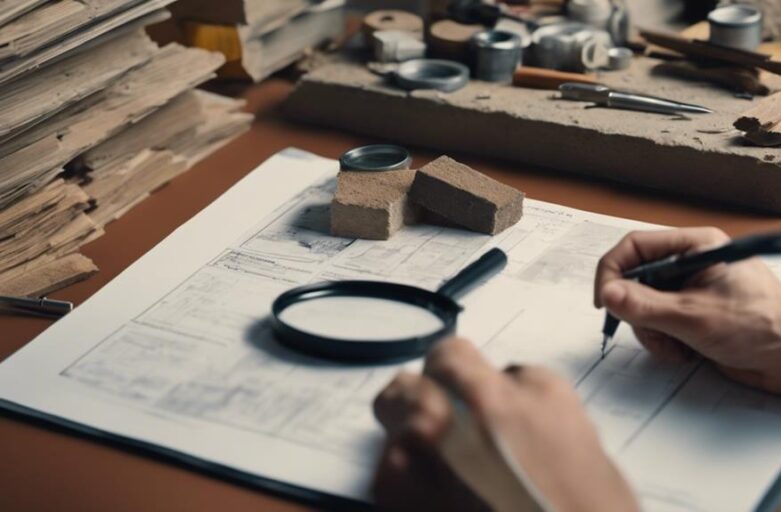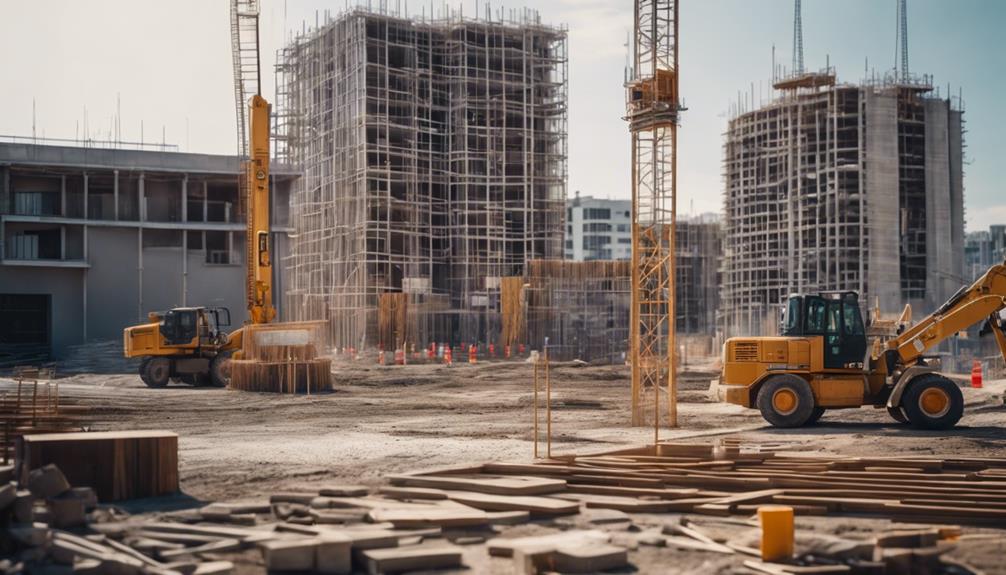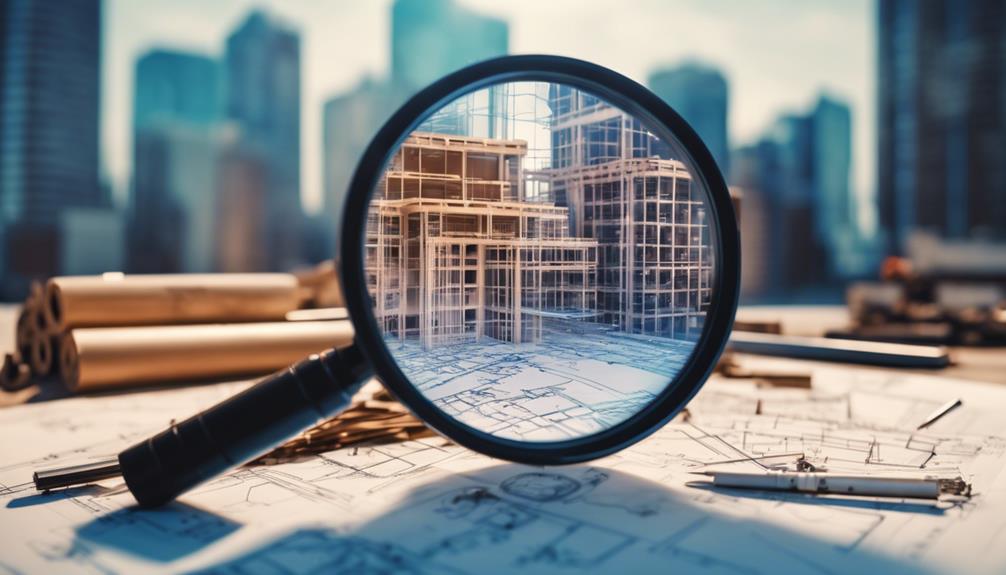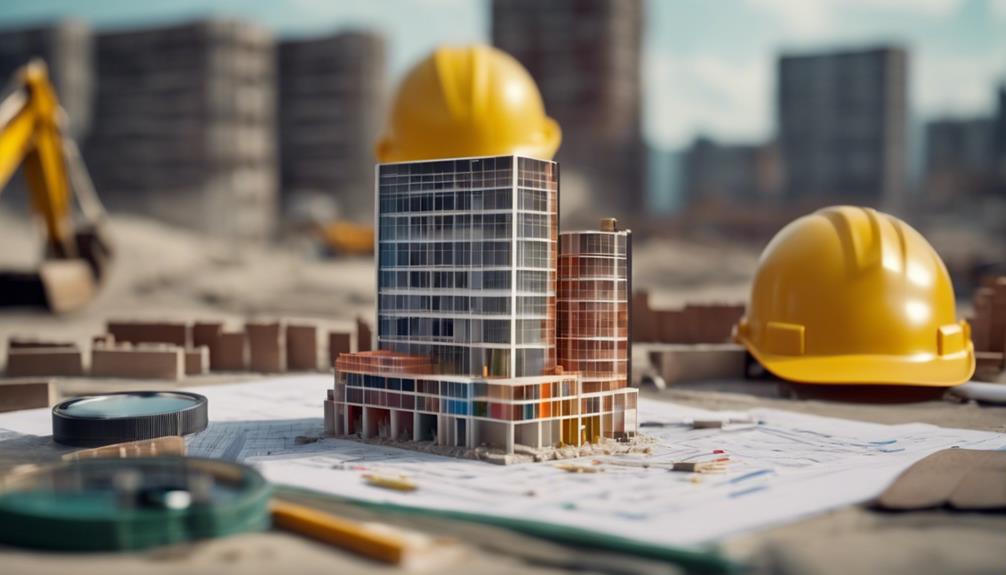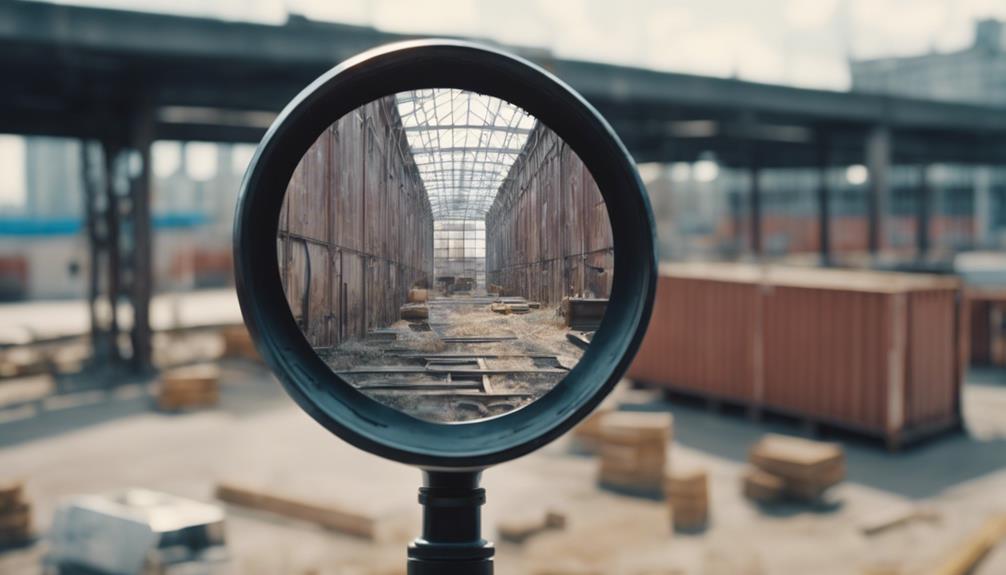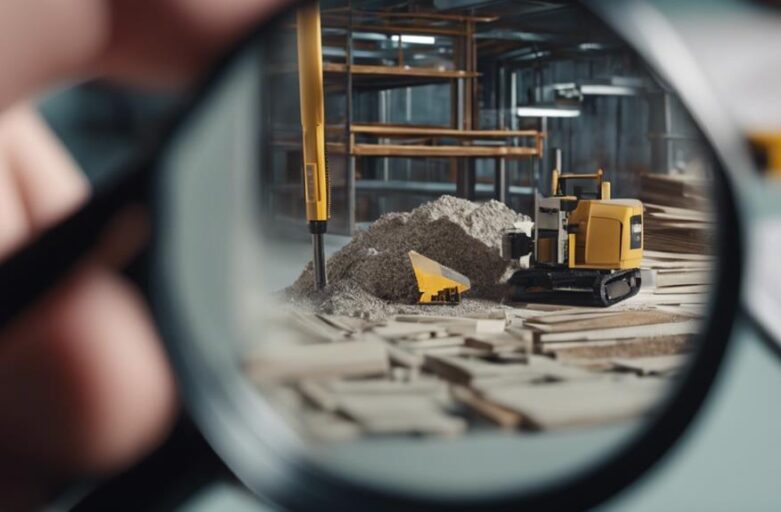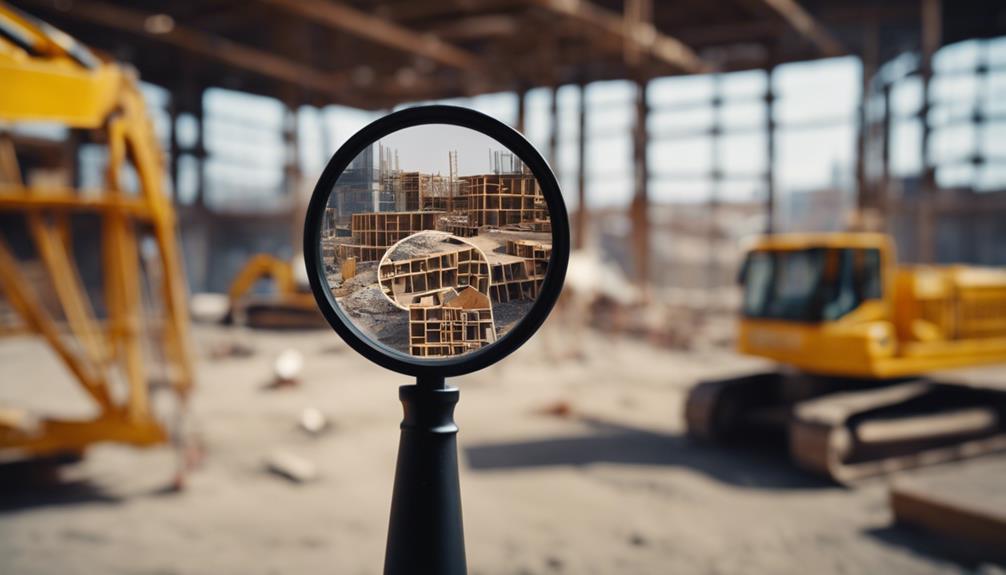To become an expert at evaluating building materials, begin with different types of tests – mechanical, chemical, and physical. You'll need a variety of tools, including analytical instruments and universal testing machines.
Make sure you know the standards like ASTM, ISO, and EN as they will guide you. Using software like LabVIEW and MATLAB will help you analyze your findings. Be organized, take care of your tools and write down everything you do.
Explore other ways to test like ultrasonic testing or moisture meters. Lab testing and following rules are crucial. Think about ways that are good for the environment and learn what to do if materials fail.
Every bit of knowledge helps you become better at this job.
Key Takeaways
- Using special tests, we can learn about the strength and other features of building materials.
- There's a cool way to check materials right at the construction site using sound waves, kind of like how bats see in the dark!
- We follow rules set by groups like ASTM, ISO, and EN to make sure our materials are safe and high quality.
- We use computer programs, like LabVIEW and MATLAB, to help us do our tests more efficiently and accurately.
- We do our best to use testing methods that are good for our planet, helping us choose materials that are kind to the environment.
Understanding Material Testing Methods
Let's dive into the fascinating world of material testing methods. These are like detective tools used to reveal the hidden qualities of materials. There are three main types of tests: mechanical, chemical, and physical.
We start our journey in the lab. Picture yourself as a scientist conducting these tests. It's not just about getting numbers; it's about making sure everything we build is safe and lasts a long time.
First up is mechanical testing. It's like a gym workout for materials. We push them to their limits to see how strong they are, how much they can bend (called ductility), and how stiff they are. This helps us choose the right materials for different building projects.
Next, imagine yourself as a chef. In chemical testing, we examine the 'ingredients' of materials to see their quality and how they react with other stuff. This is where we find out if a material could rust, and we can take steps to prevent it.
Finally, in physical testing, we look at things like how heavy a material is (its density) and how many tiny holes it has (its porosity). This lets us understand the unique qualities of different materials.
Role of Testing Equipment
Think of testing equipment as a detective's toolkit needed to uncover the secrets of building materials. It's as important as your heart is to your body. You can compare construction materials to suspects that need to be investigated. These tools will help you discover their true qualities.
Machines called Universal testing machines are like loyal friends, crucial for checking the strength and lasting power of your materials, like testing if a brick can handle a lot of weight. They give you trustworthy information about the materials you're investigating.
Then you have tools called analytical instruments. They're like science lab equipment, useful to spot and measure chemical parts in materials. They help you understand what your materials are made of, so you can make smart decisions.
There are also physical testing instruments. These are like compasses that guide you to find out the quality of your materials. They check things like how heavy a material is, how many holes it has, and how well it conducts heat.
Without these tools, testing construction materials would be like guessing in the dark. It would be like trying to solve a mystery without any clues. So, remember how important testing equipment is when you need to investigate building materials. Every tool has a vital role to play in helping you build successfully.
Importance of Testing Standards

Testing standards are really important when you're creating new things. Think of them like a map that guides you. They help you to create stuff that's innovative, trustworthy, and safe. Once you understand these standards, you can enjoy the advantages of using them.
They help you make sure you're following all the rules when you're building stuff. Remember, this is your key to doing a great job in assessing building materials.
Understanding Testing Standards
Testing standards are crucial in evaluating materials. They ensure dependability, precision, and adherence to safety rules in the construction industry. Your support for these standards shows your commitment to safety and top-notch quality.
When you follow these standards, you become part of an international group striving for the best in materials engineering. You gain from the shared knowledge of many professionals found in well-known standards like ASTM, ISO, and EN. These aren't random rules, but trusted ways to ensure the strength of your materials and the safety of your projects.
Benefits of Standardization
When we talk about why testing standards are important, we're talking about how they make your work look good, keep things safe, and make sure everything is top-notch in your building projects. Think about it like a recipe. If you use the same one every time for chocolate chip cookies, you'll always know they'll come out tasty and just right. That's what something called ASTM International does for construction materials – it's like the perfect cookie recipe, but for building stuff!
Here's a quick and easy way to understand the good things about having standards:
| Good Things | What It Means | Words to Remember |
|---|---|---|
| Looking Good | Using something like ASTM International makes people trust you more | ASTM International |
| Staying Safe | Standards make sure the stuff you use to build is safe and won't hurt anyone | Building Stuff |
| Top-Notch Work | When you follow testing standards, your buildings will be the best they can be | Building Stuff |
| Always the Same | Standards mean you'll always get the same, good results | ASTM International |
| Fewer Mistakes | If you use standards, you're less likely to make mistakes when checking your building materials | Building Stuff |
Compliance With Building Codes
Following building codes for every construction project isn't just about ticking off a list. It's your rock-solid promise of a sturdy and super safe building. Being a part of a community means you value safety, responsibility, and attention to detail.
Sticking to these codes and testing your materials well is your way to success. It keeps you from making expensive mistakes, unnecessary delays, and possible dangers. You can count on standards like ASTM, ISO, and EN. They help you in checking things correctly and consistently.
Therefore, welcome following building codes, support material testing, and maintain the topmost standards of your job. This isn't only about following rules. It's about being a part of something, being dedicated to your work, and making safe, lasting buildings.
Implementing Material Testing Software

If you want to check how good the stuff you're using to build things is, you can use special computer programs like LabVIEW, MATLAB, and Excel. These help you gather, read, and share your information about your building materials.
Here's how it works:
| Program | What it does | Why it's cool |
|---|---|---|
| LabVIEW | Collects data | Makes gathering info a breeze |
| MATLAB | Reads the data | Helps you understand what the info means |
| Excel | Lets you share your findings | Makes your results easy for everyone to understand |
These programs don't just keep your info neat and tidy. They help you really understand what's going on with your building stuff in a way that's easy to get.
Best Practices in Material Testing
Material testing is like detective work. You need a good plan, the right tools, and clear notes. Let's break this down.
First, you need a plan. It's like a treasure map, guiding you step-by-step. A well-made plan helps avoid mistakes and keeps you on track.
Next, the tools. In your case, it's your lab equipment. Keep them in top shape by checking them regularly. This way, you can trust the data they give you. It's like knowing your compass is always pointing North.
Lastly, take clear notes. It's not just about filling in blanks. Think of it as writing a book that others can read and understand. You're not just making things; you're also helping others learn.
Advanced Field Testing Techniques
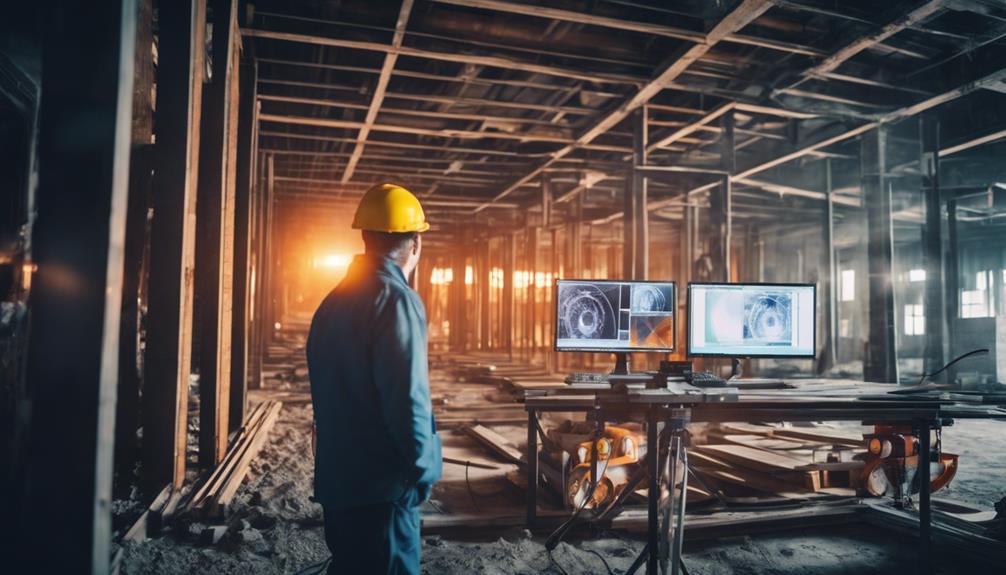
In the exciting world of advanced field testing, we've a bunch of cool tools that help us understand the health of a building without damaging it. For instance, infrared thermography is like a magical window that lets us see inside building materials. It helps us spot heat changes that might mean there's a hidden issue.
Then there's something called ground-penetrating radar (GPR). It works almost like X-ray vision, helping us see what's underneath the surface and check if everything is strong and secure. This tool is super important for making sure buildings are safe.
Another technique is ultrasonic testing. It's like a doctor's stethoscope for buildings, measuring how thick materials are and finding any flaws in concrete and other stuff.
We also use moisture meters to check if water is sneaking into places it shouldn't be. This helps us stop potentially expensive and messy problems before they happen.
Another helpful tool is acoustic emission testing. It listens to the sounds a structure makes to tell if it's starting to wear out.
These techniques are like detectives, helping us understand the heart of a building. They're important tools for anyone who needs to check on the health of a building. So, if you're interested in buildings and how to keep them safe and strong, these advanced field testing methods are definitely worth learning about!
Overview of Laboratory Testing
Lab testing is super important when it comes to checking out building materials. Just think of it like a detective's investigation, but instead of crime scenes, we're looking at stuff like bricks, cement, and beams. We take little bits of these materials and send them to a special place called a laboratory.
In the lab, these samples get a full check-up. We find out all sorts of things about them. How strong are they? Will they last a long time? What're they made of? How do they react to different things? This is all super important to know so we can decide if they're good enough to use in our buildings.
And why do we do all this? Simple. We want to make sure that every building is safe, top quality, and works just right. After all, wouldn't you want to live or work in a building that's been checked out to make sure it's the best it can be?
Regulatory Compliance in Construction
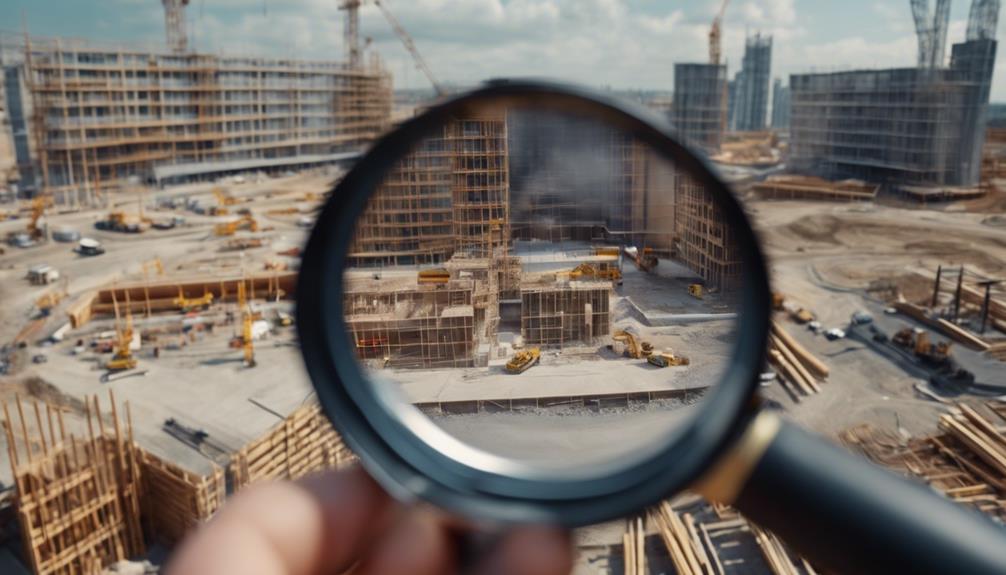
No doubt, following rules in building projects is super important. These rules make sure everything used and done in construction meets tough standards. These standards are set by big groups like ASTM International and USACE.
When you're part of a building project, you're in a group that cares a lot about safety and quality. Think about when you test materials. It's not just a step you do, it's about proving that you're committed to these values. It's a way to make sure your materials are top-notch and will last a long time.
Following these rules also saves you from big, expensive mistakes. It makes sure your project is built strong and sturdy, in every sense. It's not just about checking things off a list. It's about building something that's safe, tough, and made to last.
Sustainable Test Methods
Sustainable testing methods are a cool way to check the quality of building materials. They also help us protect the environment. These methods are like a magical balance scale. On one side, they keep the cost of testing materials low. On the other side, they make sure the materials are safe, reliable, and sturdy.
Using these methods is a big step towards using eco-friendly building materials and methods. And guess what? You're not alone in this! We all are working together to make construction more environment-friendly.
| Good Things About Sustainable Testing | How It Helps the Life of Building Stuff |
|---|---|
| It's good for the environment | It makes materials last longer, reducing waste |
| It's cheaper | It saves money in the long run |
| It meets environmental rules | It lowers the risk of breaking environmental rules |
| It uses cool tech | It improves the performance of materials, making them last longer |
| It encourages green building | It makes us choose eco-friendly materials, improving the project life |
Sustainable testing isn't just a fad. It's about respecting the environment, using new technology, and making construction stuff last longer. By using these green methods, you're part of a group that cares about the environment and the quality of our buildings. You play a big role in making construction more sustainable.
Handling Construction Material Failures
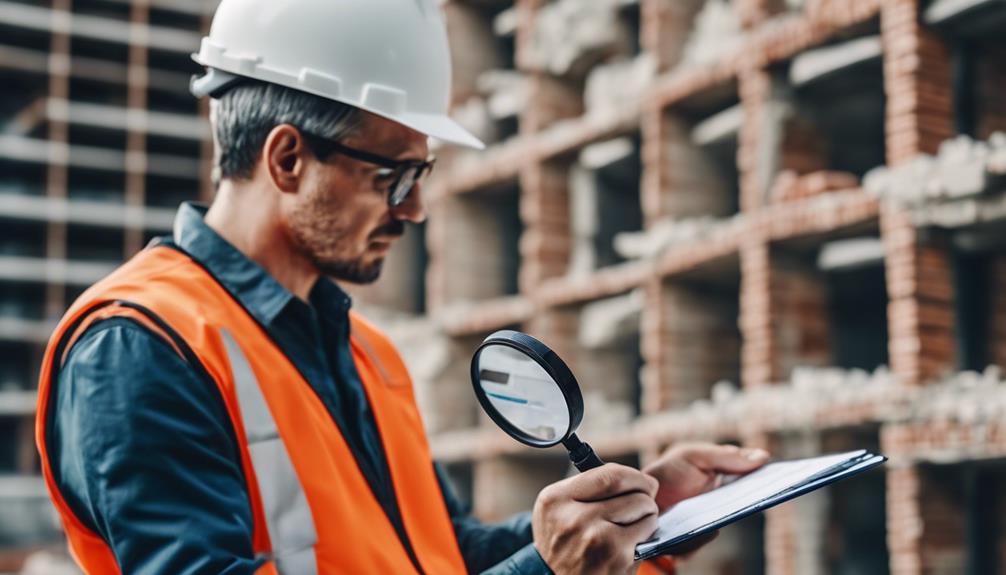
Building something big can be a tough job, especially when the stuff you're using to build it doesn't work as expected. This can make it risky to work, delay your project, and make it more expensive. The materials might fail because of bad design, poor quality work, or the environment. But hey, don't worry – you're not fighting this alone.
A big part of dealing with this is to really look into the building materials you're using. Don't miss out on anything. This means you need to really get into the details to find out what caused the problems and spot any possible failures before they turn into big, expensive issues. But remember, it's not just about finding what's wrong. It's also about finding ways to make sure your project is solid and safe.
Think about it – with a careful check of your building materials, you can make sure your construction is strong and lasts a long time. You can be proud, knowing your project is safe and protects everyone who'll use your building.
Conclusion
Great job! You've become a pro at checking building materials. You know that tests, rules, and special tools are super important.
You're using computer programs and understand why certain ways of doing things work best. You're always making sure you follow regulations and think about the environment.
Even when things go wrong, you stay cool. Well done! Your work is making buildings safer, better, and more efficient.
Keep it up; what you're doing really matters.…


